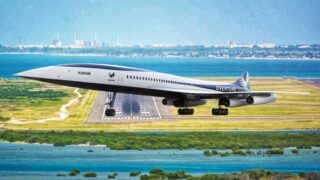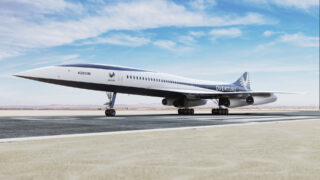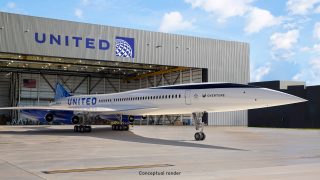With the promise of reducing Hawaii flight times by half and still facing very significant, if not insurmountable, challenges, including environmental concerns, engine development hurdles, and high costs, Boom is moving forward very rapidly—so much so that it plans to test a supersonic flight within the next sixty days.
The race toward Mach 1.
On October 25, 2024, XB-1 completed its sixth test flight at Mojave Air & Space Port, climbing to a record altitude of 20,000 feet and reaching speeds of Mach 0.67 over a 38-minute flight.
This series of subsonic test flights—planned at approximately 10 total—sets the stage for breaking the sound barrier before the end of the year. Following October’s handling and performance test flight, Boom said it would pick up the pace of test flights, moving closer to the supersonic threshold before the new year.
Airliner’s technology platform or simply a test aircraft?
Boom says that their XB-1 isn’t merely a test aircraft but rather the technology platform for their Overture passenger airliner. Others have disagreed.
At the core of Boom’s ambitious design—and potential challenges—is its Symphony jet engine, a project Boom took in-house after Rolls-Royce exited the partnership in 2022.
Developing Symphony has added complexity and cost, yet Boom sees the in-house approach as essential for moving forward. As we await more Symphony updates, Boom reports that recent combustor tests show encouraging results, representing a crucial hurdle toward Overture’s commercial viability.
Overture’s potential impact on Hawaii travel.
With XB-1 fast approaching the sound barrier, Boom says it is moving ever closer to its ultimate goal of a supersonic passenger airliner capable of cutting flight times from the U.S. West Coast to Hawaii by nearly half.
Operating at speeds up to Mach 1.7, Overture aims to connect Hawaii with cities such as Los Angeles, San Francisco, and Seattle in under three hours, compared to the typical five-hour flight. And that’s just for starters in terms of route opportunities.
This far shorter flight time could transform Hawaii’s tourism landscape, making the islands more accessible while reducing travel fatigue. Overture is designed to operate at net-zero carbon emissions and will run on sustainable aviation fuel (SAF).
Boom’s big challenges and considerations.
While the idea of supersonic Hawaii travel is fascinating, if not enticing, Boom faces significant challenges and considerations. One of those is its environmental impact.
Some readers have pointed out that supersonic aircraft generally consume more fuel per passenger than subsonic jets, making the sustainability of such travel a point of contention.
One Beat of Hawaii reader, Janet L., expressed interest in shorter flights to Hawaii but voiced reservations about the higher fuel consumption: “Shorter flights sound great, but will they be too costly for the environment?”
Another limitation is the “sonic boom,” or the loud noise produced when an aircraft breaks the sound barrier. Current regulations restrict supersonic flight over land, meaning that Overture could only fly at supersonic speeds over the ocean.
This restriction makes Hawaii an ideal destination for Boom’s technology. Still, it limits the scope of possible supersonic U.S. routes to West Coast coastal cities like Los Angeles, San Francisco, and Seattle.
Cost is another consideration. Supersonic flights have historically been expensive, and while Boom aims to make Overture more affordable than Concorde was, ticket prices are still expected to be higher than typical first-class fares.
As a result, supersonic flights may be less accessible for many travelers. Another BOH reader, Mark R., expressed his concerns: “Supersonic sounds exciting, but if ticket prices are only accessible to the wealthy, I’m not sure what it means for the average traveler.”
Read Boom Supersonic’s Groundbreaking News To Transform Hawaii Travel.
The latest Boom video is below.
What do XB-1 and Overture have in common?
— Boom Supersonic (@boomaero) October 16, 2024
From transferable technologies to developing team capabilities and a safety-first culture, XB-1 VP Jeff Mabry details how XB-1 sets a strong foundation for the development of Overture. pic.twitter.com/6vIh2EZHbw
We welcome your thoughts on Boom SST!
Get Breaking Hawaii Travel News






The backwards Hawaii goverment will never allow Boom…it would be more likely they force tourists to arrive only via outriggers than allow Boom (or any other technological step forward).
supersonic sounds wonderful
cost is the only deciding factor for consumers but if introduction to chartered flight can get the ball rolling
mach 1 over the ocean slow down to Vegas just under mach 1
with two daily round trips within 24 hours profits can go up quickly
Aloha
I was fortunate to go to ground school on the Concorde – never flew it as the industry was falling backwards at a “high rate of speed” in those days. I was also in Seattle when Boeing’s SST program was cancelled. So I suppose one might say I’ve B T D T when it comes to “supersonic” commercial air transport in the U.S.A.
Reality check time: the Boom XB-1 or “Baby Boom” is a one-third-scale trijet supersonic demonstrator designed by Boom Technology. It is 68′ long, has a 17’wingspan, and is 17′ in height.
I M O, it is a vanity project, pure and simple. It will never make scheduled flights from the Mainland to Hawai’i with passengers or cargo during the lifetime of anyone reading this …
Please sign me up for supersonic Hawaii-to-Paris in 6 hours.
I would fly this in a heartbeat! Every trip! The expense is of no concern to me!
All the speculation on what a flight on Overture may cost is simply academic. The simple fact is that the airplane will never exist, not least of which is because its engine will never exist. The project is a scam, designed to part suckers from their money.
95% of flights between Hawaii and the mainland will be on 737s and A320s until the end of time.
You are quite correct, Sir …
I fly between Lihue and LAX 3-4 times a year. Boom SST probably will be too expensive to take that often but as an airplane technology geek I would take at least one flight just to fly super sonic!
I love the fact that you guys are providing information on future technology which may or may not benefit Hawaiian tourism.
Personally, I am looking for more comfort.
I have reached the ripe old age of 73 years. I did not fly commercial until I graduated from college. A few observations enclosed:
1. Air travel is much safer than it was 50 years ago.
2. Air travel is much more affordable than it was 50 years ago.
3. Narrow body planes with too few comforts dominate and clearly show that the traveling public has low standards.
4. First class is not what it used to be here in the USA. ( I agree that 3 seats in economy for two are better on long flights.)
5. I still have wanderlust. Do I have the stamina for contemporary air travel?
6. Does anyone check a bag anymore?
There is another miracle of modern technology rarely spoken about – its healing power. Have anyone noticed all those passengers in wheelchairs lined up at the gate which miraculously disappear at the destination and everyone happily walking off the flight? Isn’t it amazing how those few hours in the air cure them all? And then you complain how uncomfortable those cabins are!
We call them miracle flights! “It is a miracle! I can walk again!” Some call it, “Jesus jetway flights!”
All a ploy to game the system to get first & better seating for those “open seating” airlines. Then they claim they are “saving seats” for the other 8 in their family!
Now, Southwest is checking the “handicap credentials” of some of those cheaters! Should have started long ago!
Never heard of “Jesus jetway flights”. His healings were legit, & He’s legit. Not so sure of “handicap cheaters”. Federal law requires airlines to pre-board anyone “needing extra time”. Asking personal medical questions is not allowed by the airlines. Medical history confidentiality is covered by federal HIPPA laws.
If you fly, you’d know that “handicap cheaters” are real. Unless there’s a better explanation for a dozen of passengers in wheelchairs at the gate before departure and virtually zero at the destination.
Is there any mention of the needed runway length for landings and take-offs? Which Hawaii airports could accommodate the BOOM?
I am an airplane builder/mechanic, careful what you wish for.
.67 Mach isn’t much to crow about. A Dreamliner cruises at .85 Mach.
I have doubts regarding the commercial viability of Boom. The only actual example of supersonic travel was the Concorde. It was very expensive due to high fuel consumption and the low seating capacity that the skinny fuselage imposed.
I don’t see any significant advantages of the boom design that will significantly mitigate these costs.
If you’re willing to pay more for a high end ticket, would you rather get where you’re going 4 hours faster in a cramped aircraft or pay for a more spacious first class experience? For me, comfort over speed every time.